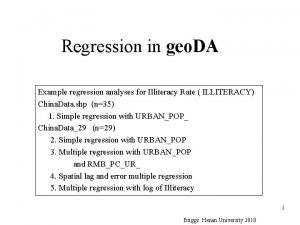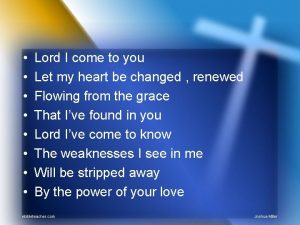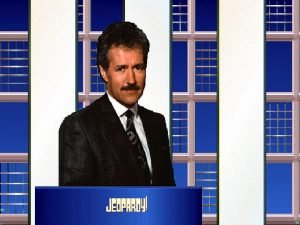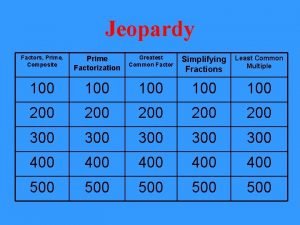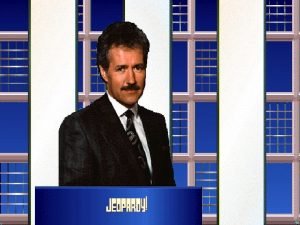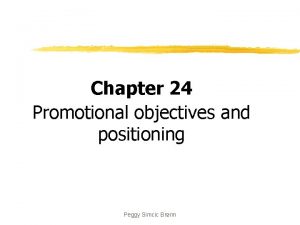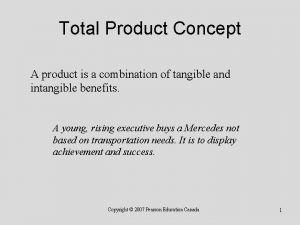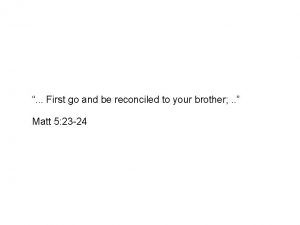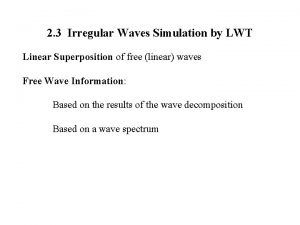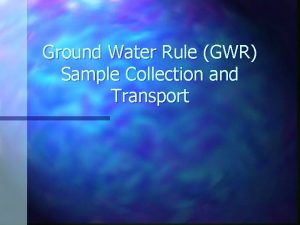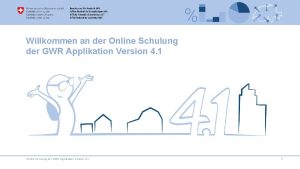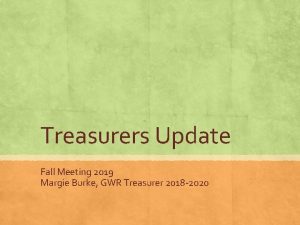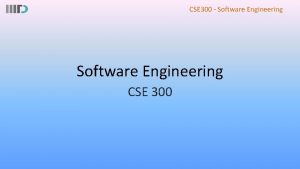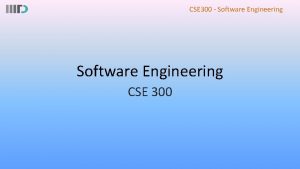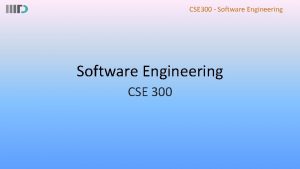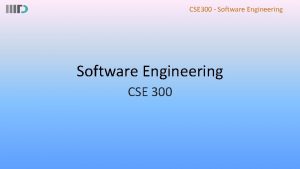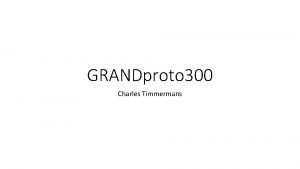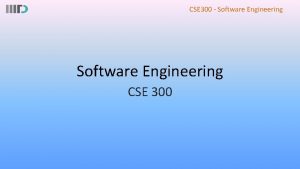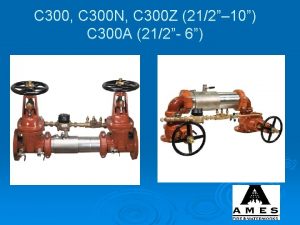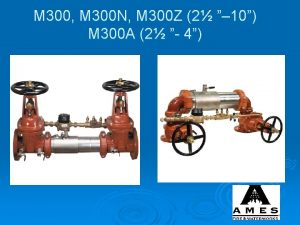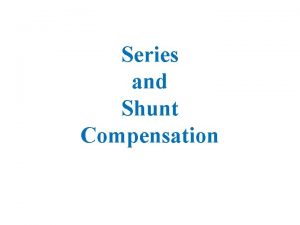LWT series A renewed GWR offering LWT 300


























- Slides: 26

— LWT series – A renewed GWR offering

— LWT 300 series Speakers Photo February 26, 2021 Slide 2 Nicolas Hô Josée Labrecque – Global Product Manager, guided wave radar & laser level measurement – Global Sales Manager, guided wave radar & laser level measurement – ABB – Based in Quebec City, Canada

— Why do you need guided wave radar? Reliable level measurement, even in difficult conditions – Radar wave confined by probe, so energy is stays high, providing reliable measurements – Suitable for high pressures and high temperatures – Can be made in materials resisting hash conditions

— How does GWR work? A radar wave is generated by the transmitter and guided by the probe – Advantage: The energy is always high providing good signals When the wave touches an interface, liquid or solid, it reflects back to the transmitter The time of flight of the wave is measured, providing a measurement of distance The dielectric constant of the materials indicates how strong the reflection will be – Water has a high DC, reflects strongly – Oils have a low DC, reflect weakly – Low density solids have a low DC – Plastics have a low DC

— The LWT 300 series The LWT series is based on – The common ABB platform – The MT 5000 coupler designs Painted aluminum or Stainless steel enclosure Common ABB menu layout TTG or pushbutton display This leads to – A renewed, state of the art, guided-wave radar electronics Head can be rotated – The common ABB look and feel Threaded or flanged interface – The heritage of the MT 5000 couplers – The new Level. Expert algorithm, making setup faster and the measurement more reliable February 26, 2021 Slide 5 Cable probe Rod probe Segmented rod probe Coaxial probe

— LWT Models and specifications GWR provides high accuracy and excellent reliability in harsh conditions Recommended applications Coupler diameter, NPT version Process temperature Process pressure Liquids Solids 3/4 in. 1 -1/2 in. -50 C to 204°C (-58°F to 400°F) up to 200 bar (2900 psi) 1. 4 Update rate 5 Hz Accuracy 2 mm (5/64 in. ) Resolution 1 mm (3/64 in. ) Protection class IP 68 /NEMA 6 P Maximum pull force Slide 6 LWT 320 Minimum DC Probes February 26, 2021 LWT 310 Cable Rigid rod Segmented rod (connected segments of 1 m) Coaxial 450 kg (1000 lb. ) 635 kg (1400 lb. )

— Different probes can be used in different contexts Cable probe Rod, segmented or continuous Coaxial probe Up to 60 m long (200 ft. ) Up to 6 m long (20 ft. ) Very convenient for shipping and handling Segmented rod are very convenient for shipping and handling Used for special applications Segments of 1 m (3 ft. ) long Relevant for low dielectrics (DC < 2) A weight is placed at the bottom to keep cable straight Cable can be cut and weight reattached February 26, 2021 Slide 7 Keeps radar pulse inside coaxial tube, high intensity No dead zone (5 cm (2 in. ) for others)

— The Level. Expert™ A GWR that anyone can use A guided wave radar that anyone can use. No need to be an expert anymore. GWR is often considered difficult to setup LWT series benefits from powerful and user-friendly way of configuring a GWR LWT series guided-wave radar With Level. Expert™: The expert inside The Level. Expert™ concentrates 20 years of industrial level measurement experience into an intelligent algorithm made to accurately detect the level even in the most demanding conditions. Forget baseline mapping and echo selection, Level. Expert™ knows how to find the right level through the clutter. The expert is now inside your guided-wave radar. February 26, 2021 Slide 8

— The Level. Expert™ A GWR that anyone can use No technical settings – No need to set a Threshold voltage – No need to set a Gain or a Shape – No need to set a Range Instead, describe the application in normal language – Is there a nozzle? How long is it? – What process conditions can be present? Enable those that apply The Level. Expert then interprets the waveform, qualifies the different radar echoes, and finds the echo corresponding to the surface level automatically February 26, 2021 Slide 9

— The Level. Expert™ A GWR that anyone can use Level. Expert analyses the waveform, detects all the echoes, and classifies them Echoes will come from the radar pulse launch, buildup on the probe, double bounces, the end of probe, etc. One echo will come from the real surface, and will be identified and tracked over time The real echo will be followed even trough the false echoes, leading to high reliability and no need to adjust the parameters when conditions change Launch echo False echo Real level February 26, 2021 Slide 10 End of probe False echo

— Remote head with long cable Placing head away from coupler Remote head with long cable, as much as 60 m (200 ft. ) The remote head option can be very convenient, for instance when – The coupler is hard to reach – The coupler is in a warm place, where uncomfortable to work – The coupler is on top of the vessel but the display needs to be at a lower level The head is separated from the coupler and probe by a coaxial cable The coaxial cable is rated for outdoor use and shielded February 26, 2021 Slide 11

— Remote head with long cable Placing head away from coupler Remote head with long cable, as much as 60 m (200 ft. ) The remote head option can be very convenient, for instance when – The coupler is hard to reach – The coupler is in a warm place, where uncomfortable to work – The coupler is on top of the vessel but the display needs to be at a lower level The head is separated from the coupler and probe by a coaxial cable The coaxial cable is rated for outdoor use and shielded February 26, 2021 Slide 12

— Very low temperature drift possible LWT series specification: Temperature drift (digital): ± 0. 2 mm/10 K (max ± 2. 5 mm) This is 15 to 50 times better than usually seen on the market Accuracy is defined at a constant temperature, it doesn’t account for drift. You must have a low temperature drift in order to benefit from high accuracy in real world applications. When is it important? When you expect high accuracy at all times, even during temperature changes Also relevant for redundant applications: when using several units, they will all drift, but they need to remain within a given range otherwise it will trigger an alarm. Low drift means efficient redundancy. February 26, 2021 Slide 13

— Faster step response for measuring fast changes Step response defines the time it takes to see 90% of an immediate change It is a better definition of instrument response time than update rate – you could update the output very fast with constant values The LWT series has a fast update rate of 5 Hz, leading to a step response time of 400 ms A step response time of 1 – 3 is usually seen on the market When is it important? A fast update rate is important for measuring rapidly filling vessel. Small vessel can fill up fast Spherical or cylindrical vessel fill up fast near the top, since the vessel diameter gets smaller near the top Fast response time is safer: less chances of overfilling February 26, 2021 Slide 14

— Scope of releases Release 1 Release 2 Future releases LWT 310 for liquid measurements MODBUS communication Interface measurement for HART – June 2020 LWT 320 for solids measurement Interface measurement Top level measurement Standard temperature (<204 C / 400 F) and pressure (205 bars / 3000 psi) HART communication Hazardous area certification, explosion proof and intrinsically safe SIL 2/3 CRN February 26, 2021 Slide 15 High pressure and temperature coupler – June 2020 Foundation Fieldbus, Profibus PA – Q 1 2021

— Probe type and length can easily be changed on site Change without having to recalibrate You can stock electronics heads separately from probes and assemble probes as needed, without recalibration You can keep, on site: – Electronics heads and couplers together – Cables and weights – Segments of rods All you need to do it tell the LWT which type of probe is used, and its length February 26, 2021 Slide 16

— Applications Storage vessel External chamber/bridle/Mag. Wave™ Storage vessels are one of the most common applications for guided wave radar. Boiler drums, feedwater heaters, compressed hydrocarbons and process vessels with multiple obstructions require external chambers. Instrument signal is not affected by steam, vapor, mist, spray, turbulence, flashing, changing pressures or temperatures, or changing dielectrics. Foam generally does not affect signal, but excessive foam can cause a negative offset. Light buildup can be managed, but heavy buildup should be avoided. February 26, 2021 Slide 17 LWT 310 is the best measurement choice for such installations Chamber concentrates signal if chamber is 100 mm (4 in) or smaller providing excellent measurements

— Applications Stilling wells / co-axial probe Horizontal cylinder Stilling wells are used if Used as settling tanks, separation vessels, and storage tanks. - the probe must be installed in the process fill stream Stilling well or co-axial probe are used: - to avoid obstructions and agitators - to retain signal strength in applications with very low dielectric fluids and long measuring lengths February 26, 2021 Slide 18 LWT 310 not affected by the internal geometry of horizontal cylinders. No false level reflections created by the cylinder walls LWT 310 is able to measure close top the end of the probe, allowing measurement until the vessel is near empty.

— Typical tank level measurement Oil with H 2 S Customer needs Configuration Feedback Reliable level measurement on oil with H 2 S and wax build up in fiberglass tank. LWT 310 25 foot long cable probe Easy setup menu allowed full configuration through integrated HMI Threaded in flange, flat metal surface provide great radar pulse launch Level. Expert allowed setup without need to look at waveform Great measurement stability over time February 26, 2021 Slide 19

— Typical external chamber installation LWT 310 on LNG tank Configuration: LWT 310 Segmented rigid rod probe External chamber Made of metal, contains radar pulse like a coaxial probe. High intensity provide very reliable measurement External chamber protects probe from potential interference from inside the main tank February 26, 2021 Slide 20

— ABB’s LWT 310 to secure tunnel from being flooded in Warsaw in Poland ABB’s client was faced with problem to choose right measuring method to prevent tunnel from being flooded. In 2013, after grand opening of a new tunnel in Warsaw there was a short but very intensive storm. False echoes of ultrasonic transmitter led to wrong valve behavior and tunnel was flooded. Customer then wanted a device immune to such false echoes which can appear in narrow well. He choose the LWT 310. Because of new Level. Expert™ algorithm the customer was able to configure the device by himself and whole commissioning only took minutes. February 26, 2021 Slide 21

— Find more information on our web site Web page: http: //bit. ly/LWTseries Technical presentation Ppt presentations Videos February 26, 2021 Slide 22

— How-to videos Playlist of 9 LWT series videos: https: //www. youtube. com/playlist? list=PLi. DMHZk. KA 7 aj 17 Zp. FP 5 W 8 Pozb. Gl. Cw. NNk February 26, 2021 Slide 23

— Summary Guided wave radars provide – high accuracy (2 mm) – Reliable measurement in harsh conditions (vapors, dust do not affect it, wetted materials can be selected appropriately) due to the high radar pulse intensity maintained by the probe GWR can be used widely in the industry The LWT 300 series, with the new Level. Expert algorithm, is very easy to use, making it possible for almost anyone to install one February 26, 2021 Slide 24

— Contact information For more information about the products radars@ca. abb. com February 26, 2021 Slide 25

February 26, 2021 Slide 26
 2simple com gwr
2simple com gwr Lord i come to you let my heart be changed renewed
Lord i come to you let my heart be changed renewed Liturgical vestments meaning
Liturgical vestments meaning 400 + 300 + 300
400 + 300 + 300 200+200+300+300
200+200+300+300 300+300+400
300+300+400 300 300 400
300 300 400 200 300 300
200 300 300 300 + 300 + 400
300 + 300 + 400 100 + 100 = 200
100 + 100 = 200 100 200 300
100 200 300 300 square root
300 square root 200+200+300
200+200+300 300+300+400
300+300+400 The prime factorization of 88 is
The prime factorization of 88 is 300+300+400
300+300+400 Heisenberg 1925 paper
Heisenberg 1925 paper Shunt-series feedback example
Shunt-series feedback example Taylor series of composite functions
Taylor series of composite functions Series aiding and series opposing
Series aiding and series opposing Taylor vs maclaurin
Taylor vs maclaurin Arithmetic sequence formula
Arithmetic sequence formula Maclaurin series vs taylor series
Maclaurin series vs taylor series Ibm p series servers
Ibm p series servers Objectives of positioning
Objectives of positioning Total product concept model
Total product concept model Be reconciled to your brother
Be reconciled to your brother
